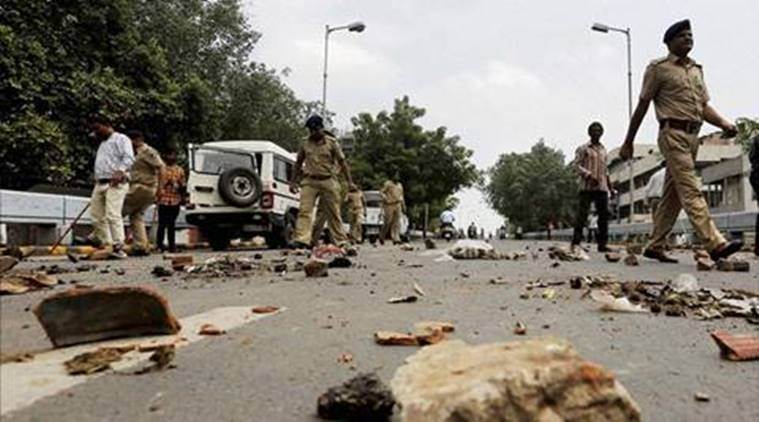How to count lynchings
Data on hate crime needs to be collected through recording bias indicators, group identity of victims and the nature of violence.
Written by Mohsin Alam Bhat | Updated: July 27, 2018 11:22:52 am

Civil society organisations have consistently demanded more comprehensive data to understand and track the upsurge of mob violence. (Photo for representation purpose)
In the midst of a perceptible rise in cases of lynching and mob violence against religious and caste minorities, the Supreme Court has called for firm action to prevent, remedy and punish these horrific acts. On July 17, the Court issued guidelines and also recommended that Parliament enact a law that establishes lynching as an offence. Considering the urgent need, these prescriptions require well-informed debate, discussion and consultation. As a starting point, comprehensive and accurate data is crucial for the proper implementation of the Court’s orders and in the larger battle against mob lynching and violence.
Civil society organisations have consistently demanded more comprehensive data to understand and track the upsurge of mob violence. For a well-informed political debate, it is imperative that we build an understanding of the contexts and motivations of these crimes. Accurate data is the necessary baseline needed to track the incidence and frequency of lynching. The learnings that emerge will expose deficits in response and accountability, and enable the design of meaningful institutional reforms in policing and prosecution.
The civil society demand stems from a dearth of reliable state-backed data. In March, in response to a question raised in Parliament on the number of lynchings that had taken place, the minister of state for home, Hansraj Ahir, provided the information that from 2014-2017, there had been 40 incidents of “lynching of people”. This is a grave understatement of the problem, not least evident from the fact that states like Haryana and Madhya Pradesh, which have seen some of the most horrific instances of mob violence, were reported to have no cases at all. In contrast, as the evidence collected by IndiaSpend suggests, during this period, there were as many as 76 cow-related violent incidents reported in English news media alone.
Perhaps because of the clamour for data, as reported in the media, the Ministry of Home Affairs has recently asked the National Crime Records Bureau (NCRB) to collect data on “mob lynching” as part of its annual Crime in India report. This will begin with the 2017 report, which will be published later this year, for which the data collection should be ongoing. In the absence of any information in the public domain of any proposed parameters on the basis of which this complex data is being collected, several critical questions arise.
There is no indication that the NCRB has laid down a definition of lynching. How lynching is defined is central to collecting data on it, particularly as it needs to be distinguished from acts of violence perpetrated for any motivation. The newness of dealing with this issue makes it difficult even for the police to understand what “mob lynching” means. With a phrase so open to interpretation without proper guidelines, the incidents will inevitably be recorded arbitrarily and divergently across police stations. It is not clear if NCRB will record the group identity of the victims. With nothing to go on, it also can be presumed that NCRB plans to record this category only in cases of murders, thus excluding a range of other crimes including sexual violence. Unless substantially supplemented and also disaggregated into its components at the collection stage, this mode of collecting data on “mob lynching” will not yield anything meaningful about the nature and impact of this violence. Even more alarmingly, these inaccuracies may well lead to further obfuscation and even evading of state accountability.
The reason why comprehensive data is essential is not because mob violence is a method of violence, but because growing evidence strongly suggests it is motivated by prejudice and bias against weaker sections and minorities. The pertinent category here is “hate crimes” or “hate violence”, which refers to violence motivated partly or wholly by bias, prejudice or hatred towards the identity of the victim. The Supreme Court in its July 17 judgment alluded to this category when it observed that “hate crimes as a product of intolerance, ideological dominance and prejudice ought not to be tolerated”. Collecting hate crime data allows us to meaningfully inform public discussion about the vulnerability of various social groups, the state of social relationships and the effectiveness of the criminal justice system.
Respected international data-collection techniques record hate crimes based on the evidence of bias motivation. Since motivations are open to interpretation, evaluation and investigation, they specifically record those objective circumstances that signal the crimes to be motivated by bias. These circumstances, also called “bias indicators”, may include the nature of violence, alleged reasons, and affiliation to organisations. In line with this, rather than asking police officers to assess motivation in the abstract, they can be asked to collect data on violence connected with gau raksha, inter-faith relationships, child-abduction, religious and national symbols, among others. These would stand as bias indicators and facilitate better understanding of the nature of crimes. The social identity of the victims and the type of violence must also be recorded to generate useful data.
Collecting hate crime data through recording bias indicators, group identity of victims and the nature of violence is urgently needed. Moving into this challenging new terrain, the NCRB will have to overhaul its processes substantially in order to generate authentic data. It must establish proper training modules for police officials who supply it with data. It must also consider putting in place self-reporting mechanisms for hate violence as well as other crimes in order to generate comprehensive data. Self-reporting is now being widely used by hate-crime monitoring systems as well as police departments across the world. In the absence of these measures, it will remain counterproductive, even dangerous, to rely solely on “official data” as it is, and to consider it more authentic than the data being collected by media and civil society organisations.
The writer is assistant professor of law and executive director, Centre for Public Interest Law, Jindal Global Law School
For all the latest Opinion News, download Indian Express App






































No hay comentarios:
Publicar un comentario